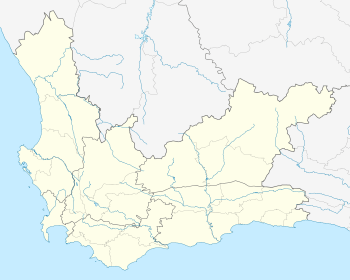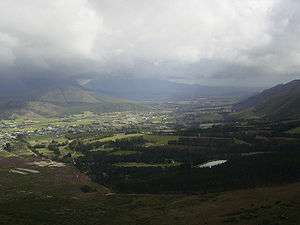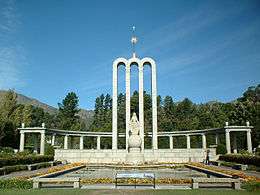Franschhoek
| Franschhoek | |
|---|---|
|
Franschhoek and Berg River Valley from Franschhoek Pass | |
 Franschhoek  Franschhoek  Franschhoek
| |
| Coordinates: 33°55′S 19°08′E / 33.917°S 19.133°ECoordinates: 33°55′S 19°08′E / 33.917°S 19.133°E | |
| Country | South Africa |
| Province | Western Cape |
| District | Cape Winelands |
| Municipality | Stellenbosch |
| Established | 1688 |
| Area[1] | |
| • Total | 3.3 km2 (1.3 sq mi) |
| Population (2011)[1] | |
| • Total | 15,616 |
| • Density | 4,700/km2 (12,000/sq mi) |
| Racial makeup (2011)[1] | |
| • Black African | 46.2% |
| • Coloured | 47.0% |
| • Indian/Asian | 0.5% |
| • White | 5.3% |
| • Other | 1.0% |
| First languages (2011)[1] | |
| • Afrikaans | 52.3% |
| • IsiXhosa | 34.7% |
| • English | 4.6% |
| • Sesotho | 3.3% |
| • Other | 5.1% |
| Postal code (street) | 7690 |
| PO box | 7690 |
| Area code | 021 |

Franschhoek ([frɐnsˈɦuk]; Afrikaans for "French Corner", Dutch spelling before 1947 Fransche Hoek) is a small town in the Western Cape Province and one of the oldest towns of the Republic of South Africa. It is about 75 kilometres from Cape Town and has a population of slightly over 15,000 people. Since 2000 it has been incorporated into Stellenbosch Municipality.
History
The valley was originally settled in 1688 by 176 French Huguenot refugees, many of whom were given land by the Dutch government in a valley called Olifantshoek ("Elephants' corner"), so named because of the elephants that crossed into the valley to calve. The name of the area soon changed to le Coin Français ("the French Corner"), and later to Franschhoek (Dutch for "French Corner"), with many of the settlers naming their new farms after the areas in France from which they came.[2] La Motte, Champagne, La Cotte, Cabrière, La Provence, Bourgogne, La Terra de Luc and La Dauphine were among some of the first established farms — most of which still retain their original Cape Dutch farm houses today. These farms have grown into renowned wineries. Many of the surnames in the area are of French origin, e.g. Du Toit, Marais, Du Plessis, Malan, Malherbe, and Joubert.

This heritage is shown today by the Huguenot Monument which stands at the end of the town. The museum nearby chronicles the history of the first settlers, with each of the original Huguenot farms having its own fascinating story to tell. The Cape Dutch architecture in much of the village is unspoilt, as restrictions have been placed on the extent of renovations and new construction in order to preserve the spirit of the original settlers to the area.
In 1904 a 27 km branch line was built between Paarl and Franschhoek to serve as an alternative to ox drawn carts for farmers wanting to get their produce to market. Steam locomotives operated along the route until diesel locomotives took over in the 1970s and then, in the 1990s, as the need for rail transport decreased, service along the railway line was discontinued. The branch line was reinstated in 2012 [3][4] by a private operator and now sees service as the Franschhoek Wine Tram,[5][6] a tourism project utilizing a newly constructed tram modeled after the open-sided Brill Trams of circa 1890 to transport tourists between wine estates in the area.
Recent developments
Once a sleepy country retreat, the village began experiencing a boom in the 1990s, and property prices have sharply increased. The ideal summer weather, snowy peaks in winter and proximity to Cape Town have turned Franschhoek into one of South Africa's most sought after residential addresses. The construction of the new English-medium private Bridge House School outside the village has also attracted many urban dwellers to the village.
Franschhoek is notable for having some of the top restaurants in the country within its borders. This fact, together with the strong wine culture, and pristine natural and architectural beauty has made Franschhoek into what many describe as the "food and wine capital" of South Africa. The city hosts one of the TOP 50 restaurants in the world, according to the "S.Pellegrino world's 50 best restaurants"-ranking and a famous Belgian Pâtisserie for Belgian pralines.
The attributes of the village have turned Franschhoek into a popular tourist destination, with dozens of bed & breakfasts and small cottages available for accommodation.
Franschhoek's weekend Bastille Festival has been celebrated every July since 1994, the year of the first South African general election with universal adult suffrage marking the end of the apartheid era.[7][8]
See also
References
- 1 2 3 4 Sum of the Subplaces Langrug, Groendal and Hugenote from Census 2011.
- ↑ [The Old Buildings of the Cape, Hans Fransen. Jonathan Ball Publishers:Cape Town. p.283]
- ↑ Cape Argus - Fran tram to rattle winelands
- ↑ Paarl Post - Franschhoek wine tram here
- ↑ Virgin Atlantic - Cape Winelands: New Franschhoek Wine Tram
- ↑ Franschhoek Wine Valley - Franschhoek Wine Tram
- ↑ "Oui, it's Bastille Day in Franschhoek". Mail & Guardian. 14 July 2007. Archived from the original on 14 July 2014. Retrieved 14 July 2014.
- ↑ "2014 Franschhoek Bastille Day Festival". CapeTownMagazine.com. Archived from the original on 14 July 2014. Retrieved 14 July 2014.
This time around, the annual get-together celebrates its 21st birthday
| Wikimedia Commons has media related to Franschhoek. |
| Wikivoyage has a travel guide for Franschhoek. |

.svg.png)